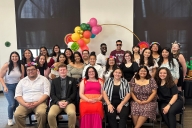You have /5 articles left.
Sign up for a free account or log in.
Engineering students at Arizona State University need not leave their slick new dormitory on the college’s Tempe campus for some of their classes. A couple of classrooms are just a quick walk down the hall -- and some of their rooms are equipped with Amazon’s latest tech, the Echo Dot, a way for them to learn voice-recognition technology.
Arizona State officials say their residential model has always assigned some students to buildings based on degree -- integrative science in arts in some spaces, business in another, and with the continued popularity of science, technology, engineering and mathematics programs, they could see the concept being replicated more widely.
The features of the $120 million building that opened this fall, called the Tooker House, would likely excite students with its contemporary touches, like the spacious dining hall and Bluetooth-enabled laundry rooms that can send notifications to students’ smartphones when a load is done. In an interview, though, Bradley Bolin, Arizona State’s assistant director of residential life, talked up the community bonding and academic benefits for students.
Classrooms where beginner engineering courses are taught, featuring 3-D printers, laser cutters and the “tools and nuts and bolts” those students would require, Bolin said, are constantly in use. Tutoring centers are located on the first floor.
While many other colleges maintain homes or dormitories for people with common interests, such as the environment, or the French language and culture, both those programs are a step removed from only housing people of certain majors. Other institutions have residential colleges that may feature classrooms and study spaces in the same building where students live, but those students tend to come from many different fields of study.
Breaking the ice can also prove difficult for first-year students, but not as much if they see one another in classes and can bond that way, Bolin said.
“They notice each other in the academic setting we create there and form social bonds because of that,” he said. “They can say, ‘Here, I have that book already -- we can share.’ It creates an opportunity to start dialogue.”
Such amenities come with a price -- either $8,175 or $8,575 per academic year, depending on if a student wants a shared or private room. And meal plans are required for those living in the apartment-style dormitories, or if they’re in their first year at Arizona State, which can cost up to a little more than $5,200 extra.
Comparatively, rooms in one of the institution's upper-division housing units, the North Residence Halls building, costs between $4,980 and $5,931 for the year.
Asked about the price of the engineering dorm, Bolin said he knows “it’s always on families’ minds” but that when officials do tours, they market the specialness of the dormitory and all the features.
“It’s all the amenities we have --they can get more bang for the buck,” Bolin said. “Let’s make sure they know about all the amazing opportunities to connect with faculty, and those connections can lead to internships, which are going to lead to opportunities.”
The previous building for engineering students had aged, said Kyle Squires, dean of the Ira A. Fulton Schools of Engineering, and the university needed to decide whether to renovate or start from scratch.
In the past decade, the engineering program had seen a surge in enrollment, too, he said.
Tooker House can accommodate nearly 1,600 residents -- a fraction of the more than 20,000 enrolled in the undergraduate and graduate engineering programs at Arizona State, about 2,800 of whom are freshmen.
Upper-level students can live in the more traditional style of residence hall not delineated by major.
In building something completely new, the university wanted to innovate, Squires said -- not just have the dormitory serve as a space for students to eat and then return to their rooms. While students were particularly keen on the more superficial features -- such as the fitness center -- Squires said when they were giving feedback on what the dormitory should have, they delved into academic-related services, too.
“The common spaces are inviting and also easy to get to within the residence hall, in a way you’re going to walk by your colleagues on a regular basis,” he said.
While Squires said he was unaware of anyone duplicating the Tooker House idea (surprising, considering the popularity of STEM disciplines), he intends to share the progress on it at an upcoming conference of college and university deans and gather ideas for how the model could be improved.
Daniel Ocampo, adviser to the National Association of College and University Residence Halls, said via email that his organization has seen a national trend in residence life of partnering more with the academic side of colleges and universities. He was unaware of any dormitory quite like Arizona State's, but he said he has seen similar programs.
At the University of the Pacific, where Ocampo serves as director of residential life and student engagement, officials tried a “residential learning community” for freshman engineering majors, an attempt to retain those students.
“While I think we could have developed more strategies, and further develop the program, the School of Engineering didn’t feel that it was worth the effort and withdrew from the collaboration,” he said.








